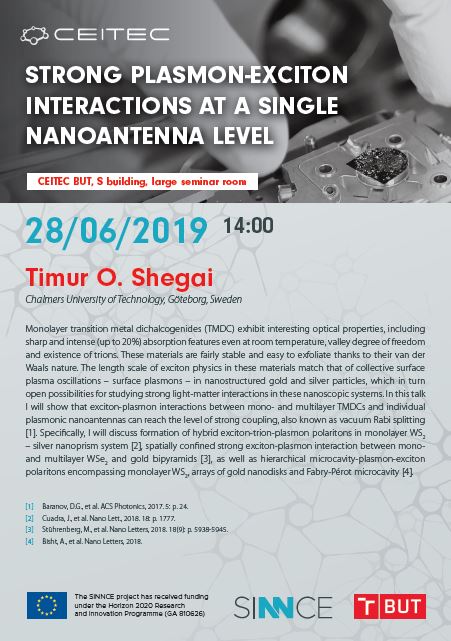STRONG PLASMON-EXCITON INTERACTIONS AT A SINGLE NANOANTENNA LEVEL
 Monolayer transition metal dichalcogenides (TMDC) exhibit interesting optical properties, including sharp and intense (up to 20%) absorption features even at room temperature, valley degree of freedom and existence of trions. These materials are fairly stable and easy to exfoliate thanks to their van der Waals nature. The length scale of exciton physics in these materials match that of collective surface plasma oscillations – surface plasmons – in nanostructured gold and silver particles, which in turn open possibilities for studying strong light-matter interactions in these nanoscopic systems. In this talk I will show that exciton-plasmon interactions between mono- and multilayer TMDCs and individual plasmonic nanoantennas can reach the level of strong coupling, also known as vacuum Rabi splitting [1].
Monolayer transition metal dichalcogenides (TMDC) exhibit interesting optical properties, including sharp and intense (up to 20%) absorption features even at room temperature, valley degree of freedom and existence of trions. These materials are fairly stable and easy to exfoliate thanks to their van der Waals nature. The length scale of exciton physics in these materials match that of collective surface plasma oscillations – surface plasmons – in nanostructured gold and silver particles, which in turn open possibilities for studying strong light-matter interactions in these nanoscopic systems. In this talk I will show that exciton-plasmon interactions between mono- and multilayer TMDCs and individual plasmonic nanoantennas can reach the level of strong coupling, also known as vacuum Rabi splitting [1].
Specifically, I will discuss formation of hybrid exciton-trion-plasmon polaritons in monolayer WS2
– silver nanoprism system [2], spatially confined strong exciton-plasmon interaction between mono- and multilayer WSe2 and gold bipyramids [3], as well as hierarchical microcavity-plasmon-exciton polaritons encompassing monolayer WS2, arrays of gold nanodisks and Fabry-Pérot microcavity [4].
[1] Baranov, D.G., et al. ACS Photonics, 2017. 5: p. 24.
[2] Cuadra, J., et al. Nano Lett., 2018. 18: p. 1777.
[3] Stührenberg, M., et al. Nano Letters, 2018. 18(9): p. 5938-5945.
[4] Bisht, A., et al. Nano Letters, 2018.